Deck 5: The Structure and Function of Large Biological Molecules
Question
Question
Question
Question
Question
Question
Question
Question
Question
Question
Question
Question
Question
Question
Question
Question
Question
Question
Question
Question
Question
Question
Question
Question
Question
Question
Question
Question
Question
Question
Question
Question
Question
Question
Question
Question
Question
Question
Question
Question
Question
Question
Question
Question
Question
Question
Question
Question
Question
Question
Question
Question
Question
Question
Question
Question
Question
Question
Question
Question
Question
Question
Question
Question
Question
Question
Question
Question
Question
Question

Unlock Deck
Sign up to unlock the cards in this deck!
Unlock Deck
Unlock Deck
1/70
Play
Full screen (f)
Deck 5: The Structure and Function of Large Biological Molecules
1
Starch and cellulose ________.
A) are polymers of glucose
B) are cis and trans isomers of each other
C) are used for energy storage in plants and animals
D) are structural components of the plant cell wall
A) are polymers of glucose
B) are cis and trans isomers of each other
C) are used for energy storage in plants and animals
D) are structural components of the plant cell wall
A
2
Which of the following best summarizes the relationship between dehydration reactions and hydrolysis?
A) Dehydration reactions assemble polymers; hydrolysis reactions break polymers apart.
B) Dehydration reactions eliminate water from membranes; hydrolysis reactions add water to membranes.
C) Dehydration reactions and hydrolysis reactions assemble polymers from monomers.
D) Hydrolysis reactions create polymers, and dehydration reactions create monomers.
A) Dehydration reactions assemble polymers; hydrolysis reactions break polymers apart.
B) Dehydration reactions eliminate water from membranes; hydrolysis reactions add water to membranes.
C) Dehydration reactions and hydrolysis reactions assemble polymers from monomers.
D) Hydrolysis reactions create polymers, and dehydration reactions create monomers.
A
3
Use the following figure to answer the question.
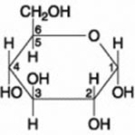
The molecule shown is ________.
A) a hexose
B) a pentose
C) fructose
D) maltose

The molecule shown is ________.
A) a hexose
B) a pentose
C) fructose
D) maltose
A
4
What is the major structural difference between starch and glycogen?
A) the types of monosaccharide subunits in the molecules
B) the type of glycosidic linkages in the molecule
C) whether glucose is in the α or β form
D) the amount of branching that occurs in the molecule
A) the types of monosaccharide subunits in the molecules
B) the type of glycosidic linkages in the molecule
C) whether glucose is in the α or β form
D) the amount of branching that occurs in the molecule

Unlock Deck
Unlock for access to all 70 flashcards in this deck.
Unlock Deck
k this deck
5
You would like to lose weight. Which of the following should be your preferred food group?
A) Lactose and glucose
B) Sucrose and starch
C) Starch and fructose
D) Cellulose and fructose
A) Lactose and glucose
B) Sucrose and starch
C) Starch and fructose
D) Cellulose and fructose

Unlock Deck
Unlock for access to all 70 flashcards in this deck.
Unlock Deck
k this deck
6
In carbohydrates, the ratio of hydrogen (H) to oxygen (O) is ________.
A) 1:1
B) 2:1
C) 3:1
D) 4:1
A) 1:1
B) 2:1
C) 3:1
D) 4:1

Unlock Deck
Unlock for access to all 70 flashcards in this deck.
Unlock Deck
k this deck
7
Which of the following is not a polymer?
A) glucose
B) starch
C) RNA
D) DNA
A) glucose
B) starch
C) RNA
D) DNA

Unlock Deck
Unlock for access to all 70 flashcards in this deck.
Unlock Deck
k this deck
8
Maltose is a disaccharide that can easily be digested into glucose molecules. The glycosidic linkage between glucose molecules in maltose is ________.
A) β 1-4
B) α 1-2
C) α 1-4
D) β 1-2
A) β 1-4
B) α 1-2
C) α 1-4
D) β 1-2

Unlock Deck
Unlock for access to all 70 flashcards in this deck.
Unlock Deck
k this deck
9
What makes lipids/fats hydrophobic?
A) their long carbon skeleton
B) the carboxyl group at one end of the molecule
C) the glycerol moiety
D) presence of relatively nonpolar C-H bonds
A) their long carbon skeleton
B) the carboxyl group at one end of the molecule
C) the glycerol moiety
D) presence of relatively nonpolar C-H bonds

Unlock Deck
Unlock for access to all 70 flashcards in this deck.
Unlock Deck
k this deck
10
Which polysaccharide is an important component in the structure of many animals and fungi?
A) chitin
B) cellulose
C) amylopectin
D) amylose
A) chitin
B) cellulose
C) amylopectin
D) amylose

Unlock Deck
Unlock for access to all 70 flashcards in this deck.
Unlock Deck
k this deck
11
The molecular formula for glucose is C₆H₁₂O₆. What would be the molecular formula for a molecule made by linking three glucose molecules together by dehydration reactions?
A) C₁₈H₃₆O₁₈
B) C₁₈H₃₂O₁₆
C) C₆H₁₀O₅
D) C₁₈H₃₀O₁₅
A) C₁₈H₃₆O₁₈
B) C₁₈H₃₂O₁₆
C) C₆H₁₀O₅
D) C₁₈H₃₀O₁₅

Unlock Deck
Unlock for access to all 70 flashcards in this deck.
Unlock Deck
k this deck
12
Which of the following statements is true for lipids?
A) Lipids are true polymers.
B) Waxes and pigments are not lipids.
C) Lipids mix poorly with water.
D) Lipids are true polymers and mix poorly with water.
A) Lipids are true polymers.
B) Waxes and pigments are not lipids.
C) Lipids mix poorly with water.
D) Lipids are true polymers and mix poorly with water.

Unlock Deck
Unlock for access to all 70 flashcards in this deck.
Unlock Deck
k this deck
13
The difference between an aldose sugar and a ketose sugar is ________.
A) the number of carbon atoms
B) the position of the hydroxyl groups
C) the position of the carbonyl group
D) the ring form and the linear chain
A) the number of carbon atoms
B) the position of the hydroxyl groups
C) the position of the carbonyl group
D) the ring form and the linear chain

Unlock Deck
Unlock for access to all 70 flashcards in this deck.
Unlock Deck
k this deck
14
People who are lactose intolerant cannot extract energy from milk because ________.
A) they are missing an enzyme
B) lactose is too big to be digested by the enzymes
C) milk is fermented to a by-product, which cannot be digested
D) they are missing the bacteria that can digest lactose
A) they are missing an enzyme
B) lactose is too big to be digested by the enzymes
C) milk is fermented to a by-product, which cannot be digested
D) they are missing the bacteria that can digest lactose

Unlock Deck
Unlock for access to all 70 flashcards in this deck.
Unlock Deck
k this deck
15
How many molecules of water are released during the polymerization of a 20 monomer-long cellulose molecule?
A) 10
B) 19
C) 20
D) 40
A) 10
B) 19
C) 20
D) 40

Unlock Deck
Unlock for access to all 70 flashcards in this deck.
Unlock Deck
k this deck
16
Humans can digest starch but not cellulose because ________.
A) humans have enzymes that can hydrolyze the α-glycosidic linkages of starch but not the β-glycosidic linkages of cellulose
B) starch monomers are joined by covalent bonds, and cellulose monomers are joined by ionic bonds
C) the monomer of starch is glucose, while the monomer of cellulose is galactose
D) Starch is softer than cellulose
A) humans have enzymes that can hydrolyze the α-glycosidic linkages of starch but not the β-glycosidic linkages of cellulose
B) starch monomers are joined by covalent bonds, and cellulose monomers are joined by ionic bonds
C) the monomer of starch is glucose, while the monomer of cellulose is galactose
D) Starch is softer than cellulose

Unlock Deck
Unlock for access to all 70 flashcards in this deck.
Unlock Deck
k this deck
17
Starch is composed of ________.
A) branched amylopectin and branched amylose
B) unbranched amylopectin and unbranched amylose
C) branched amylopectin and unbranched amylose
D) unbranched amylopectin and branched amylose
A) branched amylopectin and branched amylose
B) unbranched amylopectin and unbranched amylose
C) branched amylopectin and unbranched amylose
D) unbranched amylopectin and branched amylose

Unlock Deck
Unlock for access to all 70 flashcards in this deck.
Unlock Deck
k this deck
18
What does the term insoluble fiber refer to on food packages?
A) cellulose
B) polypeptides
C) starch
D) amylopectin
A) cellulose
B) polypeptides
C) starch
D) amylopectin

Unlock Deck
Unlock for access to all 70 flashcards in this deck.
Unlock Deck
k this deck
19
A molecule with the chemical formula C₆H₁₂O₆ is probably a ________.
A) fatty acid
B) polysaccharide
C) nucleic acid
D) monosaccharide
A) fatty acid
B) polysaccharide
C) nucleic acid
D) monosaccharide

Unlock Deck
Unlock for access to all 70 flashcards in this deck.
Unlock Deck
k this deck
20
A glycosidic linkage is analogous to which of the following in proteins?
A) an amino group
B) a peptide bond
C) a disulfide bond
D) a β pleated sheet
A) an amino group
B) a peptide bond
C) a disulfide bond
D) a β pleated sheet

Unlock Deck
Unlock for access to all 70 flashcards in this deck.
Unlock Deck
k this deck
21
Saturated fats ________.
A) are more common in plants than in animals
B) have multiple double bonds in the carbon chains of their fatty acids
C) are generally liquid at room temperature
D) contain more hydrogen than unsaturated fats that consist of the same number of carbon atoms
A) are more common in plants than in animals
B) have multiple double bonds in the carbon chains of their fatty acids
C) are generally liquid at room temperature
D) contain more hydrogen than unsaturated fats that consist of the same number of carbon atoms

Unlock Deck
Unlock for access to all 70 flashcards in this deck.
Unlock Deck
k this deck
22
A tripeptide has ________.
A) three amino acids and two peptide bonds
B) three amino acids and three peptide bonds
C) two amino acids and three peptide bonds
D) four amino acids and three peptide bonds
A) three amino acids and two peptide bonds
B) three amino acids and three peptide bonds
C) two amino acids and three peptide bonds
D) four amino acids and three peptide bonds

Unlock Deck
Unlock for access to all 70 flashcards in this deck.
Unlock Deck
k this deck
23
Cooking oil and gasoline (a hydrocarbon) are not amphipathic molecules because they ________.
A) do not have a polar or charged region
B) do not have a nonpolar region
C) have hydrophobic and hydrophilic regions
D) are highly reduced molecules
A) do not have a polar or charged region
B) do not have a nonpolar region
C) have hydrophobic and hydrophilic regions
D) are highly reduced molecules

Unlock Deck
Unlock for access to all 70 flashcards in this deck.
Unlock Deck
k this deck
24
Which of the following could be responsible for atherosclerosis and should be eliminated from diet for health reasons?
A) butter
B) olive oil
C) liver and kidney organ meat
D) butter, liver, and kidney organ meat
A) butter
B) olive oil
C) liver and kidney organ meat
D) butter, liver, and kidney organ meat

Unlock Deck
Unlock for access to all 70 flashcards in this deck.
Unlock Deck
k this deck
25
How do phospholipids interact with water molecules?
A) The polar heads avoid water; the nonpolar tails attract water (because water is polar and opposites attract).
B) Phospholipids do not interact with water because water is polar and lipids are nonpolar.
C) The polar heads interact with water; the nonpolar tails do not.
D) Phospholipids dissolve in water.
A) The polar heads avoid water; the nonpolar tails attract water (because water is polar and opposites attract).
B) Phospholipids do not interact with water because water is polar and lipids are nonpolar.
C) The polar heads interact with water; the nonpolar tails do not.
D) Phospholipids dissolve in water.

Unlock Deck
Unlock for access to all 70 flashcards in this deck.
Unlock Deck
k this deck
26
Use the following figure to answer the question.

The molecule illustrated in the figure ________.
A) is a saturated fatty acid
B) stores genetic information
C) will be liquid at room temperature
D) is a carbohydrate

The molecule illustrated in the figure ________.
A) is a saturated fatty acid
B) stores genetic information
C) will be liquid at room temperature
D) is a carbohydrate

Unlock Deck
Unlock for access to all 70 flashcards in this deck.
Unlock Deck
k this deck
27
Phospholipids and triglycerides both ________.
A) contain serine or some other organic compound
B) have three fatty acids
C) have a glycerol backbone
D) have a phosphate
A) contain serine or some other organic compound
B) have three fatty acids
C) have a glycerol backbone
D) have a phosphate

Unlock Deck
Unlock for access to all 70 flashcards in this deck.
Unlock Deck
k this deck
28
Which parts of the amino acids X and Y are involved in the formation of a peptide bond?
X-Y
A) amino group of X and carboxyl group of Y
B) carboxyl group of X and amino group of Y
C) carboxyl group of X and side chain of Y
D) side chains of both X and Y
X-Y
A) amino group of X and carboxyl group of Y
B) carboxyl group of X and amino group of Y
C) carboxyl group of X and side chain of Y
D) side chains of both X and Y

Unlock Deck
Unlock for access to all 70 flashcards in this deck.
Unlock Deck
k this deck
29
Which of the following statements is true about proteins?
A) Denaturation leads to bond disruption, and the molecule turns into liquid
B) Denaturation is always irreversible
C) Final folded structure can reveal the steps of protein folding
D) Some proteins form a complete 3-D structure only when they interact with their targets
A) Denaturation leads to bond disruption, and the molecule turns into liquid
B) Denaturation is always irreversible
C) Final folded structure can reveal the steps of protein folding
D) Some proteins form a complete 3-D structure only when they interact with their targets

Unlock Deck
Unlock for access to all 70 flashcards in this deck.
Unlock Deck
k this deck
30
In sickle-cell disease, as a result of a single amino acid change, the mutant hemoglobin tetramers associate with each other and assemble into large fibers. Based on this information alone, we can conclude that sickle-cell hemoglobin exhibits ________.
A) only altered primary structure
B) only altered tertiary structure
C) only altered quaternary structure
D) altered primary structure and altered quaternary structure; the secondary and tertiary structures may or may not be altered
A) only altered primary structure
B) only altered tertiary structure
C) only altered quaternary structure
D) altered primary structure and altered quaternary structure; the secondary and tertiary structures may or may not be altered

Unlock Deck
Unlock for access to all 70 flashcards in this deck.
Unlock Deck
k this deck
31
The label on a container of margarine lists "hydrogenated vegetable oil" as the major ingredient. Hydrogenated vegetable oil ________.
A) is solid at room temperature
B) has more "kinks" in the fatty acid chains
C) has fewer trans fatty acids
D) is less likely to clog arteries
A) is solid at room temperature
B) has more "kinks" in the fatty acid chains
C) has fewer trans fatty acids
D) is less likely to clog arteries

Unlock Deck
Unlock for access to all 70 flashcards in this deck.
Unlock Deck
k this deck
32
Use the following figure to answer the question.
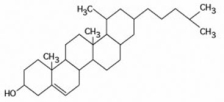
The molecule shown the figure is a ________.
A) fatty acid
B) steroid
C) triacylglycerol
D) phospholipid

The molecule shown the figure is a ________.
A) fatty acid
B) steroid
C) triacylglycerol
D) phospholipid

Unlock Deck
Unlock for access to all 70 flashcards in this deck.
Unlock Deck
k this deck
33
Which of the following provides the information necessary to stipulate a protein's 3-D shape?
A) peptide bonds between different amino acids
B) sequence of amino acids in the polypeptide chain
C) side chains of various amino acids
D) number of water molecules in the vicinity
A) peptide bonds between different amino acids
B) sequence of amino acids in the polypeptide chain
C) side chains of various amino acids
D) number of water molecules in the vicinity

Unlock Deck
Unlock for access to all 70 flashcards in this deck.
Unlock Deck
k this deck
34
Use the following information to answer the question.
"The native structure of hemoglobin (Hb) comprises of two α and two β subunits, each of which carries a heme group. There appear to be no previous studies that report the in-vitro folding and assembly of Hb from highly unfolded α and β globin in a 'one-pot' reaction. One difficulty that has to be overcome for studies of this kind is the tendency of Hb to aggregate during refolding. This work demonstrates that denaturation of Hb in 40% acetonitrile at pH 10.0 is reversible." (J Am Soc Mass Spectrum 2007, 18, 8-16)
How many heme groups are present in three hemoglobin protein molecules?
A) 3
B) 4
C) 9
D) 12
"The native structure of hemoglobin (Hb) comprises of two α and two β subunits, each of which carries a heme group. There appear to be no previous studies that report the in-vitro folding and assembly of Hb from highly unfolded α and β globin in a 'one-pot' reaction. One difficulty that has to be overcome for studies of this kind is the tendency of Hb to aggregate during refolding. This work demonstrates that denaturation of Hb in 40% acetonitrile at pH 10.0 is reversible." (J Am Soc Mass Spectrum 2007, 18, 8-16)
How many heme groups are present in three hemoglobin protein molecules?
A) 3
B) 4
C) 9
D) 12

Unlock Deck
Unlock for access to all 70 flashcards in this deck.
Unlock Deck
k this deck
35
You have just sequenced a new protein found in mice and observe that sulfur-containing cysteine residues occur at regular intervals. What is the significance of this finding?
A) Cysteine residues are required for the formation of α helices and β pleated sheets.
B) It will be important to include cysteine in the diet of the mice.
C) Cysteine residues are involved in disulfide bridges that help form tertiary structure.
D) Cysteine causes bends, or angles, to occur in the tertiary structure of proteins.
A) Cysteine residues are required for the formation of α helices and β pleated sheets.
B) It will be important to include cysteine in the diet of the mice.
C) Cysteine residues are involved in disulfide bridges that help form tertiary structure.
D) Cysteine causes bends, or angles, to occur in the tertiary structure of proteins.

Unlock Deck
Unlock for access to all 70 flashcards in this deck.
Unlock Deck
k this deck
36
Use the following information to answer the question.
"The native structure of hemoglobin (Hb) comprises of two α and two β subunits, each of which carries a heme group. There appear to be no previous studies that report the in-vitro folding and assembly of Hb from highly unfolded α and β globin in a 'one-pot' reaction. One difficulty that has to be overcome for studies of this kind is the tendency of Hb to aggregate during refolding. This work demonstrates that denaturation of Hb in 40% acetonitrile at pH 10.0 is reversible." (J Am Soc Mass Spectrum 2007, 18, 8-16)
Hemoglobin, when subjected to 40% acetonitrile at pH 10.0, loses its quaternary structure, which means the ________.
A) four α and β polypeptides dissociate
B) peptide bonds between amino acids break
C) α and β polypeptides lose their 3-D structure
D) four α and β polypeptides dissociate, peptide bonds between amino acids, and α and β polypeptides lose their 3-D structure
"The native structure of hemoglobin (Hb) comprises of two α and two β subunits, each of which carries a heme group. There appear to be no previous studies that report the in-vitro folding and assembly of Hb from highly unfolded α and β globin in a 'one-pot' reaction. One difficulty that has to be overcome for studies of this kind is the tendency of Hb to aggregate during refolding. This work demonstrates that denaturation of Hb in 40% acetonitrile at pH 10.0 is reversible." (J Am Soc Mass Spectrum 2007, 18, 8-16)
Hemoglobin, when subjected to 40% acetonitrile at pH 10.0, loses its quaternary structure, which means the ________.
A) four α and β polypeptides dissociate
B) peptide bonds between amino acids break
C) α and β polypeptides lose their 3-D structure
D) four α and β polypeptides dissociate, peptide bonds between amino acids, and α and β polypeptides lose their 3-D structure

Unlock Deck
Unlock for access to all 70 flashcards in this deck.
Unlock Deck
k this deck
37
For lipids to be fluid at room temperature, they should have ________.
A) single bonds only
B) a higher number of glycerol molecules
C) a higher number of cis double bonds
D) a longer carbon chain
A) single bonds only
B) a higher number of glycerol molecules
C) a higher number of cis double bonds
D) a longer carbon chain

Unlock Deck
Unlock for access to all 70 flashcards in this deck.
Unlock Deck
k this deck
38
What component of amino acid structure varies among different amino acids?
A) the long carbon-hydrogen tails of the molecule
B) the presence of a central C atom
C) the components of the R group
D) the glycerol molecule that forms the backbone of the amino acid
A) the long carbon-hydrogen tails of the molecule
B) the presence of a central C atom
C) the components of the R group
D) the glycerol molecule that forms the backbone of the amino acid

Unlock Deck
Unlock for access to all 70 flashcards in this deck.
Unlock Deck
k this deck
39
Use the following information to answer the question.
"The native structure of hemoglobin (Hb) comprises of two α and two β subunits, each of which carries a heme group. There appear to be no previous studies that report the in-vitro folding and assembly of Hb from highly unfolded α and β globin in a 'one-pot' reaction. One difficulty that has to be overcome for studies of this kind is the tendency of Hb to aggregate during refolding. This work demonstrates that denaturation of Hb in 40% acetonitrile at pH 10.0 is reversible." (J Am Soc Mass Spectrum 2007, 18, 8-16)
Hemoglobin is ________.
A) a tertiary protein with two polypeptides
B) a quaternary protein with two polypeptides
C) a tertiary protein with four polypeptides
D) a quaternary protein with four polypeptides
"The native structure of hemoglobin (Hb) comprises of two α and two β subunits, each of which carries a heme group. There appear to be no previous studies that report the in-vitro folding and assembly of Hb from highly unfolded α and β globin in a 'one-pot' reaction. One difficulty that has to be overcome for studies of this kind is the tendency of Hb to aggregate during refolding. This work demonstrates that denaturation of Hb in 40% acetonitrile at pH 10.0 is reversible." (J Am Soc Mass Spectrum 2007, 18, 8-16)
Hemoglobin is ________.
A) a tertiary protein with two polypeptides
B) a quaternary protein with two polypeptides
C) a tertiary protein with four polypeptides
D) a quaternary protein with four polypeptides

Unlock Deck
Unlock for access to all 70 flashcards in this deck.
Unlock Deck
k this deck
40
You disrupt all hydrogen bonds in a protein. What level of structure will be preserved?
A) primary structure
B) secondary structure
C) tertiary structure
D) quaternary structure
A) primary structure
B) secondary structure
C) tertiary structure
D) quaternary structure

Unlock Deck
Unlock for access to all 70 flashcards in this deck.
Unlock Deck
k this deck
41
The following question is based on the 15 molecules illustrated in the figure.
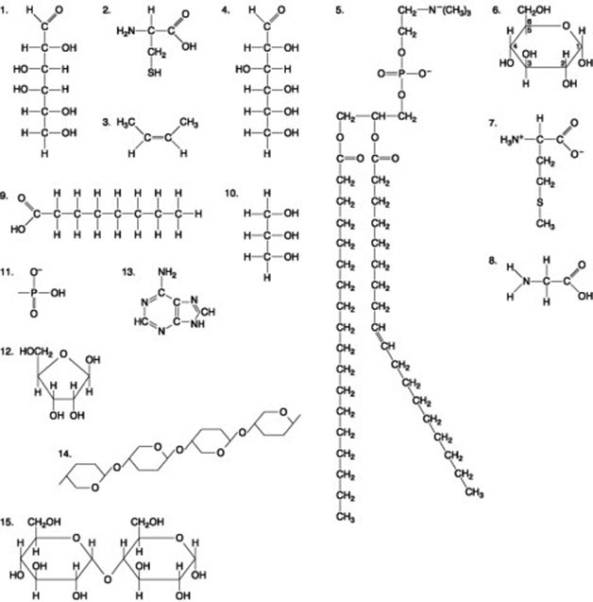
Which of the following molecules is a purine nitrogenous base?
A) 2
B) 5
C) 12
D) 13

Which of the following molecules is a purine nitrogenous base?
A) 2
B) 5
C) 12
D) 13

Unlock Deck
Unlock for access to all 70 flashcards in this deck.
Unlock Deck
k this deck
42
Which of the following is a major difference between RNA and DNA?
A) type of sugar
B) type of phosphate
C) type of purines
D) type of glycosidic bond
A) type of sugar
B) type of phosphate
C) type of purines
D) type of glycosidic bond

Unlock Deck
Unlock for access to all 70 flashcards in this deck.
Unlock Deck
k this deck
43
The following question is based on the 15 molecules illustrated in the figure.

Which of the following molecules is the pentose sugar found in RNA?
A) 1
B) 6
C) 12
D) 13

Which of the following molecules is the pentose sugar found in RNA?
A) 1
B) 6
C) 12
D) 13

Unlock Deck
Unlock for access to all 70 flashcards in this deck.
Unlock Deck
k this deck
44
Which of the following statements about the 5 end of a polynucleotide strand of RNA is correct?
A) The 5 end has a hydroxyl group attached to the number 5 carbon of ribose.
B) The 5 end has a phosphate group attached to the number 5 carbon of ribose.
C) The 5 end has phosphate attached to the number 5 carbon of the nitrogenous base.
D) The 5 end has a carboxyl group attached to the number 5 carbon of ribose.
A) The 5 end has a hydroxyl group attached to the number 5 carbon of ribose.
B) The 5 end has a phosphate group attached to the number 5 carbon of ribose.
C) The 5 end has phosphate attached to the number 5 carbon of the nitrogenous base.
D) The 5 end has a carboxyl group attached to the number 5 carbon of ribose.

Unlock Deck
Unlock for access to all 70 flashcards in this deck.
Unlock Deck
k this deck
45
If ¹⁴C-labeled uracil is added to the growth medium of cells, what macromolecules will be labeled?
A) DNA
B) RNA
C) both DNA and RNA
D) polypeptides
A) DNA
B) RNA
C) both DNA and RNA
D) polypeptides

Unlock Deck
Unlock for access to all 70 flashcards in this deck.
Unlock Deck
k this deck
46
The following question is based on the 15 molecules illustrated in the figure.
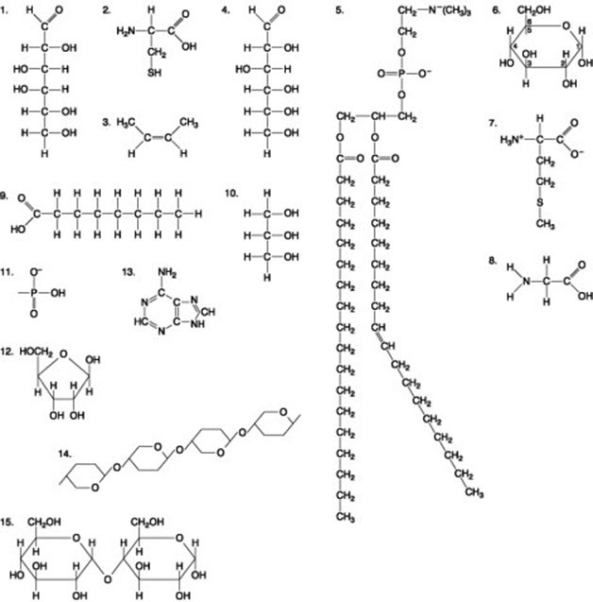
Which of the following molecules act as building blocks (monomers) of polypeptides?
A) 1, 4, and 6
B) 2, 7, and 8
C) 7, 8, and 13
D) 11, 12, and 13

Which of the following molecules act as building blocks (monomers) of polypeptides?
A) 1, 4, and 6
B) 2, 7, and 8
C) 7, 8, and 13
D) 11, 12, and 13

Unlock Deck
Unlock for access to all 70 flashcards in this deck.
Unlock Deck
k this deck
47
Use the following figure to answer the question.

The chemical reaction illustrated ________.
A) is a hydrolysis reaction
B) results in a peptide bond
C) joins two fatty acids together
D) links two polymers to form a monomer

The chemical reaction illustrated ________.
A) is a hydrolysis reaction
B) results in a peptide bond
C) joins two fatty acids together
D) links two polymers to form a monomer

Unlock Deck
Unlock for access to all 70 flashcards in this deck.
Unlock Deck
k this deck
48
Misfolding of polypeptides is a serious problem in cells. Which of the following diseases are associated with an accumulation of misfolded polypeptides?
A) Alzheimer's
B) Parkinson's
C) diabetes mellitus
D) Alzheimer's and Parkinson's
A) Alzheimer's
B) Parkinson's
C) diabetes mellitus
D) Alzheimer's and Parkinson's

Unlock Deck
Unlock for access to all 70 flashcards in this deck.
Unlock Deck
k this deck
49
When nucleotides polymerize to form a nucleic acid, ________.
A) a covalent bond forms between the sugar of one nucleotide and the phosphate of a second
B) a hydrogen bond forms between the sugar of one nucleotide and the phosphate of a second
C) covalent bonds form between the bases of two nucleotides
D) hydrogen bonds form between the bases of two nucleotides
A) a covalent bond forms between the sugar of one nucleotide and the phosphate of a second
B) a hydrogen bond forms between the sugar of one nucleotide and the phosphate of a second
C) covalent bonds form between the bases of two nucleotides
D) hydrogen bonds form between the bases of two nucleotides

Unlock Deck
Unlock for access to all 70 flashcards in this deck.
Unlock Deck
k this deck
50
One of the primary functions of RNA molecules is to ________.
A) transmit genetic information to offspring
B) function in the synthesis of proteins
C) make a copy of itself, thus ensuring genetic continuity
D) act as a pattern or blueprint to form DNA
A) transmit genetic information to offspring
B) function in the synthesis of proteins
C) make a copy of itself, thus ensuring genetic continuity
D) act as a pattern or blueprint to form DNA

Unlock Deck
Unlock for access to all 70 flashcards in this deck.
Unlock Deck
k this deck
51
In an RNA sample, ________.
A) the number of thiamine may or may not equal the number of adenine
B) the number of purine always equals the number of pyrimidine
C) the number of thiamine always equals the number of uracil
D) the number of purine may or may not equal the number of and pyrimidine
A) the number of thiamine may or may not equal the number of adenine
B) the number of purine always equals the number of pyrimidine
C) the number of thiamine always equals the number of uracil
D) the number of purine may or may not equal the number of and pyrimidine

Unlock Deck
Unlock for access to all 70 flashcards in this deck.
Unlock Deck
k this deck
52
The relation between amino acid and polypeptide is similar to the relation between ________.
A) nucleotide and nucleic acid
B) triglycerides and steroids
C) phospholipid and plasma membrane
D) glycogen and glucose
A) nucleotide and nucleic acid
B) triglycerides and steroids
C) phospholipid and plasma membrane
D) glycogen and glucose

Unlock Deck
Unlock for access to all 70 flashcards in this deck.
Unlock Deck
k this deck
53
The following question is based on the 15 molecules illustrated in the figure.
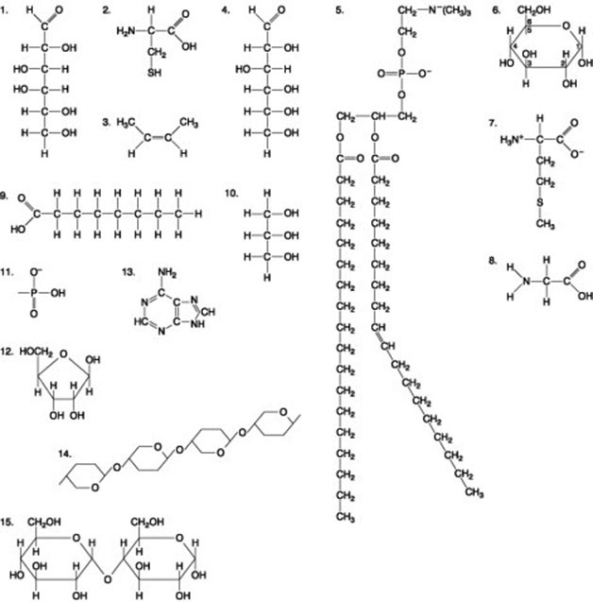
A fat (or triacylglycerol) would be formed as a result of a dehydration reaction between ________.
A) one molecule of 9 and three molecules of 10
B) three molecules of 9 and one molecule of 10
C) one molecule of 5 and three molecules of 9
D) one molecule of 5 and three molecules of 10

A fat (or triacylglycerol) would be formed as a result of a dehydration reaction between ________.
A) one molecule of 9 and three molecules of 10
B) three molecules of 9 and one molecule of 10
C) one molecule of 5 and three molecules of 9
D) one molecule of 5 and three molecules of 10

Unlock Deck
Unlock for access to all 70 flashcards in this deck.
Unlock Deck
k this deck
54
The following question is based on the 15 molecules illustrated in the figure.
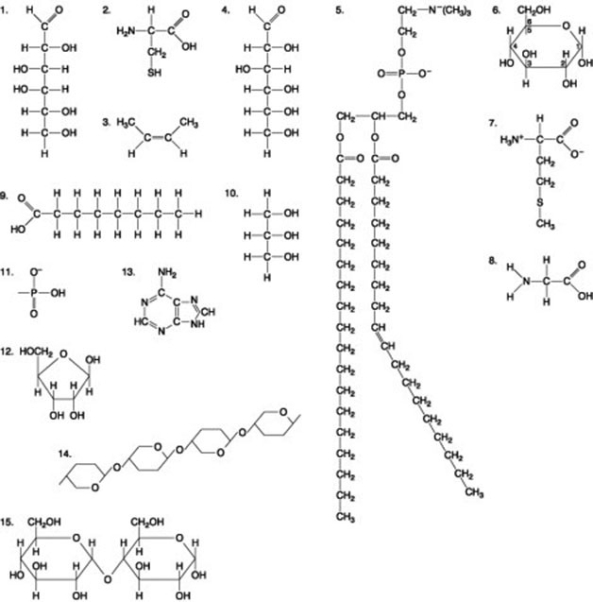
Which of the following combinations of molecules illustrated could be linked to form a nucleotide?
A) 1, 2, and 11
B) 3, 7, and 8
C) 5, 9, and 10
D) 11, 12, and 13

Which of the following combinations of molecules illustrated could be linked to form a nucleotide?
A) 1, 2, and 11
B) 3, 7, and 8
C) 5, 9, and 10
D) 11, 12, and 13

Unlock Deck
Unlock for access to all 70 flashcards in this deck.
Unlock Deck
k this deck
55
The following question is based on the 15 molecules illustrated in the figure.
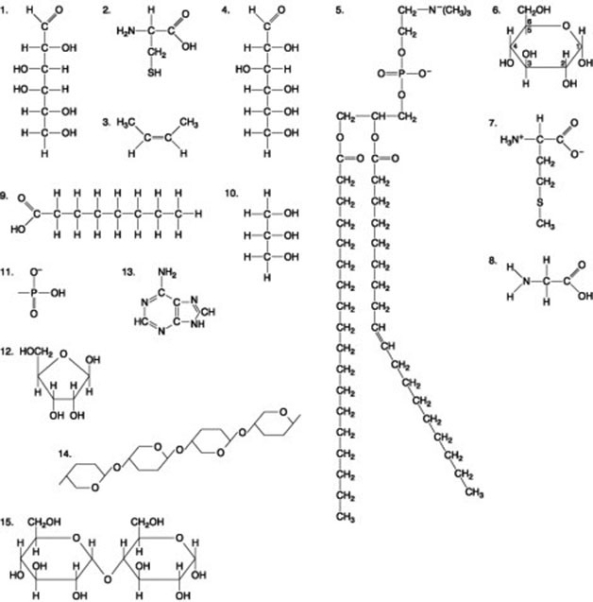
Which of the following pairs of molecules could be joined together by a peptide bond in a dehydration reaction?
A) 2 and 3
B) 7 and 8
C) 8 and 9
D) 12 and 13

Which of the following pairs of molecules could be joined together by a peptide bond in a dehydration reaction?
A) 2 and 3
B) 7 and 8
C) 8 and 9
D) 12 and 13

Unlock Deck
Unlock for access to all 70 flashcards in this deck.
Unlock Deck
k this deck
56
The following question is based on the 15 molecules illustrated in the figure.

Which molecule has both hydrophilic and hydrophobic properties and is found in plasma membranes?
A) 1
B) 5
C) 12
D) 14

Which molecule has both hydrophilic and hydrophobic properties and is found in plasma membranes?
A) 1
B) 5
C) 12
D) 14

Unlock Deck
Unlock for access to all 70 flashcards in this deck.
Unlock Deck
k this deck
57
The following question is based on the 15 molecules illustrated in the figure.
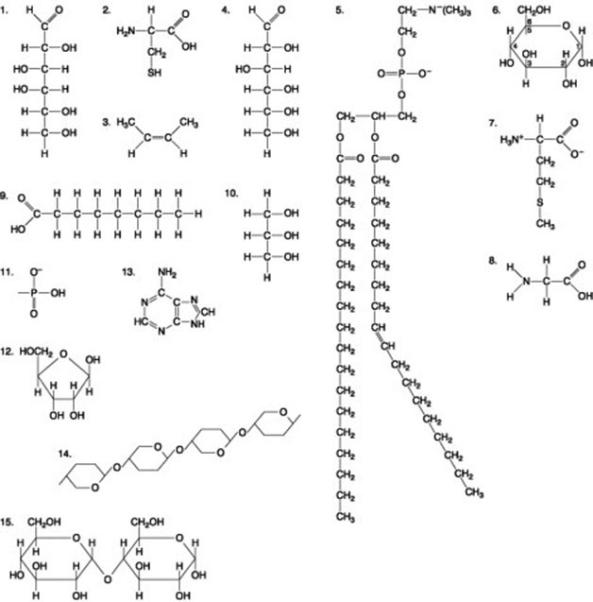
Which molecule is a saturated fatty acid?
A) 1
B) 5
C) 8
D) 9

Which molecule is a saturated fatty acid?
A) 1
B) 5
C) 8
D) 9

Unlock Deck
Unlock for access to all 70 flashcards in this deck.
Unlock Deck
k this deck
58
Which of the following descriptions best fits the class of molecules known as nucleotides?
A) a nitrogenous base and a phosphate group
B) a nitrogenous base and a sugar
C) a nitrogenous base, a phosphate group, and a sugar
D) a sugar and a purine or pyrimidine
A) a nitrogenous base and a phosphate group
B) a nitrogenous base and a sugar
C) a nitrogenous base, a phosphate group, and a sugar
D) a sugar and a purine or pyrimidine

Unlock Deck
Unlock for access to all 70 flashcards in this deck.
Unlock Deck
k this deck
59
The central rule of molecular biology states that ________.
A) DNA is transcribed into RNA, which is translated into protein
B) DNA is translated into protein
C) DNA is translated into RNA, which is transcribed into protein
D) RNA is transcribed into protein
A) DNA is transcribed into RNA, which is translated into protein
B) DNA is translated into protein
C) DNA is translated into RNA, which is transcribed into protein
D) RNA is transcribed into protein

Unlock Deck
Unlock for access to all 70 flashcards in this deck.
Unlock Deck
k this deck
60
If one strand of a DNA molecule has the sequence of bases 5′-ATTGCA-3′, the mRNA synthesized following the template will be ________.
A) 5′-TAACGT-3′
B) 5′-TGCAAT-3′
C) 3′-UAACGU-5′
D) 5′-UGCAAU-3′
A) 5′-TAACGT-3′
B) 5′-TGCAAT-3′
C) 3′-UAACGU-5′
D) 5′-UGCAAU-3′

Unlock Deck
Unlock for access to all 70 flashcards in this deck.
Unlock Deck
k this deck
61
The enzyme amylase can break glycosidic linkages between glucose monomers only if the monomers are in the form. Which of the following could amylase break down?
A) glycogen, starch, and amylopectin
B) glycogen and cellulose
C) cellulose and chitin
D) starch, chitin, and cellulose
A) glycogen, starch, and amylopectin
B) glycogen and cellulose
C) cellulose and chitin
D) starch, chitin, and cellulose

Unlock Deck
Unlock for access to all 70 flashcards in this deck.
Unlock Deck
k this deck
62
Which of the following is true of unsaturated fats?
A) They are more common in animals than in plants.
B) They have double bonds in their fatty acid chains.
C) They generally solidify at room temperature.
D) They contain more hydrogen than do saturated fats having the same number of carbon atoms.
A) They are more common in animals than in plants.
B) They have double bonds in their fatty acid chains.
C) They generally solidify at room temperature.
D) They contain more hydrogen than do saturated fats having the same number of carbon atoms.

Unlock Deck
Unlock for access to all 70 flashcards in this deck.
Unlock Deck
k this deck
63
A new organism is discovered in the forests of Costa Rica. Scientists there determine that the polypeptide sequence of hemoglobin from the new organism has 72 amino acid differences from humans, 65 differences from a gibbon, 49 differences from a rat, and 5 differences from a frog. These data suggest that the new organism is more closely related to ________.
A) humans than to frogs
B) frogs than to humans
C) rats than to frogs
D) gibbons than to rats
A) humans than to frogs
B) frogs than to humans
C) rats than to frogs
D) gibbons than to rats

Unlock Deck
Unlock for access to all 70 flashcards in this deck.
Unlock Deck
k this deck
64
Which of the following pairs of base sequences could form a short stretch of a normal double helix of DNA?
A) 5′-AGCT-3′ with 5′-TCGA-3′
B) 5′-GCGC-3′ with 5′-TATA-3′
C) 5′-ATGC-3′ with 5′-GCAT-3′
D) All of these pairs are correct.
A) 5′-AGCT-3′ with 5′-TCGA-3′
B) 5′-GCGC-3′ with 5′-TATA-3′
C) 5′-ATGC-3′ with 5′-GCAT-3′
D) All of these pairs are correct.

Unlock Deck
Unlock for access to all 70 flashcards in this deck.
Unlock Deck
k this deck
65
Homo sapiens have 23 pairs of chromosomes. This implies that ________.
A) 46 double-stranded DNA molecules are present in each somatic cell
B) 23 single-stranded DNA molecules are present in each somatic cell
C) 23 double-stranded DNA molecules are present in each somatic cell
D) several hundreds of genes are present on DNA but not on the chromosomes
A) 46 double-stranded DNA molecules are present in each somatic cell
B) 23 single-stranded DNA molecules are present in each somatic cell
C) 23 double-stranded DNA molecules are present in each somatic cell
D) several hundreds of genes are present on DNA but not on the chromosomes

Unlock Deck
Unlock for access to all 70 flashcards in this deck.
Unlock Deck
k this deck
66
Which of the following categories includes all others in the list?
A) disaccharide
B) polysaccharide
C) starch
D) carbohydrate
A) disaccharide
B) polysaccharide
C) starch
D) carbohydrate

Unlock Deck
Unlock for access to all 70 flashcards in this deck.
Unlock Deck
k this deck
67
Enzymes that break down DNA catalyze the hydrolysis of the covalent bonds that join nucleotides together. What would happen to DNA molecules treated with these enzymes?
A) The two strands of the double helix would separate.
B) The phosphodiester linkages of the polynucleotide backbone would be broken.
C) The pyrimidines would be separated from the deoxyribose sugars.
D) All bases would be separated from the deoxyribose sugars.
A) The two strands of the double helix would separate.
B) The phosphodiester linkages of the polynucleotide backbone would be broken.
C) The pyrimidines would be separated from the deoxyribose sugars.
D) All bases would be separated from the deoxyribose sugars.

Unlock Deck
Unlock for access to all 70 flashcards in this deck.
Unlock Deck
k this deck
68
Absorbance at Various pH Levels

The table represents the results of an experiment where the effects of pH buffers on an enzyme found in saliva (amylase) were studied. A spectrophotometer set at 500 nm was used to measure absorbance at the various pH levels every 20 seconds for 2 minutes. The higher absorbance values would indicate greater enzyme activity. All experiments were conducted at the same temperature.
Which statement correctly identifies the result that the optimum pH for amylase function is 7?
A) The pH with the lowest absorbance values would indicate the optimum pH for amylase since this pH does not affect the structure or function of the protein.
B) The pH with the highest absorbance values would indicate the optimum pH for amylase since this pH does not affect the structure or function of the protein.
C) At pH 9, the enzyme is denatured and will lose its function, but not its structure.
D) At pH 4, the structure of the enzyme will be altered, and the enzyme would not be able to catalyze the reaction.

The table represents the results of an experiment where the effects of pH buffers on an enzyme found in saliva (amylase) were studied. A spectrophotometer set at 500 nm was used to measure absorbance at the various pH levels every 20 seconds for 2 minutes. The higher absorbance values would indicate greater enzyme activity. All experiments were conducted at the same temperature.
Which statement correctly identifies the result that the optimum pH for amylase function is 7?
A) The pH with the lowest absorbance values would indicate the optimum pH for amylase since this pH does not affect the structure or function of the protein.
B) The pH with the highest absorbance values would indicate the optimum pH for amylase since this pH does not affect the structure or function of the protein.
C) At pH 9, the enzyme is denatured and will lose its function, but not its structure.
D) At pH 4, the structure of the enzyme will be altered, and the enzyme would not be able to catalyze the reaction.

Unlock Deck
Unlock for access to all 70 flashcards in this deck.
Unlock Deck
k this deck
69
The structural level of a protein least affected by a disruption in hydrogen bonding is the
A) primary level.
B) secondary level.
C) tertiary level.
D) quaternary level.
A) primary level.
B) secondary level.
C) tertiary level.
D) quaternary level.

Unlock Deck
Unlock for access to all 70 flashcards in this deck.
Unlock Deck
k this deck
70
The molecular formula for glucose is C₆H₁₂O₆. What would be the molecular formula for a polymer made by linking ten glucose molecules together by dehydration reactions?
A) C₆₀H₁₂₀O₆₀
B) C₆₀H₁₀₂O₅₁
C) C₆₀H₁₀₀O₅₀
D) C₆₀H₁₁₁O₅₁
A) C₆₀H₁₂₀O₆₀
B) C₆₀H₁₀₂O₅₁
C) C₆₀H₁₀₀O₅₀
D) C₆₀H₁₁₁O₅₁

Unlock Deck
Unlock for access to all 70 flashcards in this deck.
Unlock Deck
k this deck



